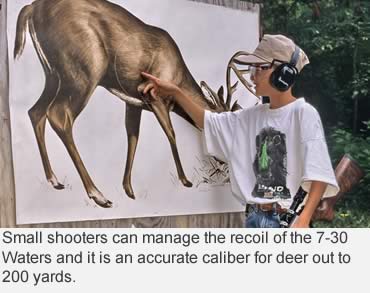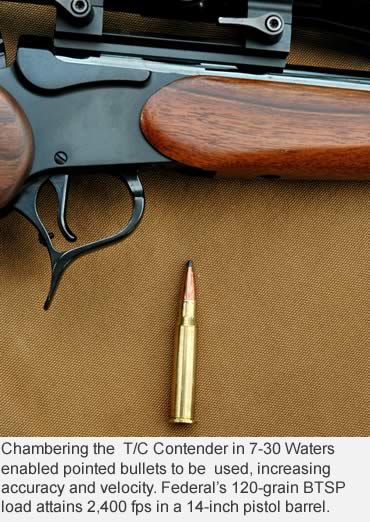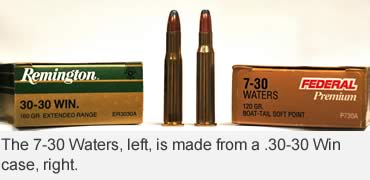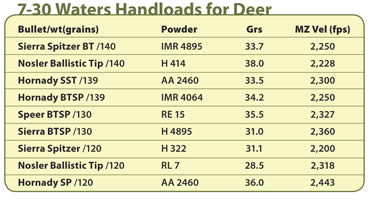By J. Wayne Fears
Great First Deer Caliber for Youngsters! The offspring of the .30-30 has mild recoil, and is effective on whitetails out to 200 yards.
The cabin door opened with authority as my 13-year old grandson Justin walked in. It was his first time to hunt deer alone, and I thought for him to be coming back to the cabin so soon, there must be a problem.
“I got a deer,” he told me and his dad with a big grin. Relieved there wasn’t a problem, I answered, “Another doe. Good shooting!”
Our farm was in a quality deer management program, and Justin was helping me reduce the number of does while looking for a sizable buck. He had become an excellent, safe shooter and had hunted with his dad and me for several years.
Thinking it was a doe, I didn’t go with Justin and his dad to retrieve the deer. While they were gone, I reflected on the last few years, and I was glad we selected the youth version of the single-shot T/C Contender carbine in the little-known 7-30 Waters caliber for him to use as his first deer rifle.
Justin had always been a small-framed youngster. The compact rifle in the low-recoil caliber had been an ideal first rifle for him. I was with him when he took his first few does, and he made clean one-shot kills on each, several out to 150 yards.
 A Good Recommendation
A Good Recommendation
Our search for the perfect first deer rifle started when Justin first became interested in deer hunting. His dad and I were looking at rifles in .243 Win and .257 Roberts to start him off on his hunting career.
A good hunting friend of mine, Ken French, then general manager at Thompson/Center Arms and a member of the team that designed the Contender, suggested we take a look at the 7-30 Waters. It is one of his favorite calibers. He has used it in a T/C Contender handgun to take deer, wild hogs and pronghorn antelope.
Due to its accuracy out to 200 yards, French says the cartridge is one of the best for youths, women and senior hunters.
Based on French’s recommendation, we got Justin a youth version of the T/C Contender carbine in 7-30 Waters. It was a perfect match.
The History
The 7-30 Waters was born in 1977 when Ken Waters, a well-known gun writer, started working to improve the range and downrange energy performance of the lever-action carbines such as the Winchester Model 94 and Marlin 336. He chose the .30-30 Win case and necked it down to receive the 7mm bullet. It started out as a wildcat cartridge, but in 1983 it caught the attention of Winchester (U.S. Repeating Arms) and Federal. Working together, U.S. Repeating Arms developed a Winchester Model 94 for the new cartridge, and Federal developed the factory loads to feed it.
 The new cartridge was almost named 7x30 Waters in the beginning, but it was given the name 7-30 Waters to avoid confusion over case length. In Europe, the designation of 7x30, with the X in the middle, would imply a 7mm cartridge, 30mm in length. That would be incorrect for this cartridge, as the 30 here refers to its parent case, the .30-30 Win. Thus the name for the new cartridge officially became 7-30 Waters.
The new cartridge was almost named 7x30 Waters in the beginning, but it was given the name 7-30 Waters to avoid confusion over case length. In Europe, the designation of 7x30, with the X in the middle, would imply a 7mm cartridge, 30mm in length. That would be incorrect for this cartridge, as the 30 here refers to its parent case, the .30-30 Win. Thus the name for the new cartridge officially became 7-30 Waters.
Due to the tubular feed of cartridges into the chamber of the lever action Model 94, only round or flat-nose bullets could be loaded in 7-30 Waters. (For safety reasons, sharply pointed bullets, other than those with rubber tips, are not used in tube-fed firearms, because the sharp point of the bullet would rest against the primer of the next cartridge in the magazine, creating a potential for a cartridge to fire in the magazine.) Because of this, the Winchester could not utilize the vast selection of spire point bullets available in 7mm, and the Winchester Model 94 in 7-30 Waters never was a best seller, and it was discontinued after a few years of poor sales.
However, in 1986, Thompson/Center began chambering 10-inch, 14-inch and 20-inch Contender barrels in 7-30 Waters. This made the 7-30 Waters an instant hit with handgun hunters who reload. The rimmed case makes it a winner for use in single-shot handguns. Also the single shot eliminated the need to worry about the shape of bullets, and the great choice of 7mm bullets was available to Contender shooters who reloaded. The Contender handgun saved the life of the 7-30 Waters as a hunting cartridge, and soon 7-30 Waters became a popular caliber with shooters of Contender carbines and, later, rifles.
 At this writing, the Thompson/Center G2 Contender is the only commercially produced firearm in 7-30 Waters. It is available in a rifle version with 23-inch barrel and either a walnut or composite stock.
At this writing, the Thompson/Center G2 Contender is the only commercially produced firearm in 7-30 Waters. It is available in a rifle version with 23-inch barrel and either a walnut or composite stock.
This is an ideal rifle for the beginning deer hunter. It is lightweight at 5.3 pounds and compact, with an overall length of just 36 3/4 inches. It is a safe rifle, as it is a single-shot, break-open design. It requires a hammer to be cocked before the rifle can be fired. The safety is an automatic hammer block with bolt interlock.
The rifle is quality through and through. It is drilled and tapped for scope mounting and has sling swivel studs for attaching a sling.
One of the best features of the G2 Contender is that the receiver will take any of the barrels available from Thompson/Center. If a youngster wants to use it as a .22 Long Rifle or .410 shotgun, the barrels can be changed in seconds by removing the fore-end and tapping out the barrel/frame hinge pin. It’s an entire shooting system, giving the shooter several guns in one by just purchasing barrels.
A hunting handgun version in 7-30 Waters with a 14-inch barrel is also available.
Federal still offers the 7-30 Waters as a factory load in its Vital-Shok brand. It features a 120-grain Sierra GameKing BTSP-FN bullet which has a muzzle velocity of 2,700 fps and muzzle energy of 1,942 foot-pounds. At 150 yards, the energy load is about 1,190 foot-pounds, plenty to bring down a big buck. Zeroed at 100 yards, the bullet strikes 5.1 inches low at 200 yards.
Load Your Own
If your youngster shoots a Contender rifle and not one of the older Winchesters, then you will want to consider reloading to make this little rifle a 200-yard sledgehammer. By taking advantage of the selection of spire point bullets that are available in 7mm, you can do a lot to improve the downrange accuracy and energy delivery. The 7-30 Waters is an easy cartridge to reload.
To begin, you will either need to purchase a supply of 7-30 Waters cases from Federal Premium Ammunition or neck down and fire-form spent.30-30 Win cases.
 Once you have a supply of cases, it is simply a matter of selecting loads suitable for shooting deer out to 200 yards. Bullets such as the Nosler 120- and 140-grain Ballistic Tip, Sierra 120-, 130- and 140-grain Spitzer, Hornady 139-grain BTSP and the Speer 130-grain BTSP are ideal for deer-size animals out to 200 yards, when fired from the G2 Contender rifle, or handgun with a suitable load of powder.
Once you have a supply of cases, it is simply a matter of selecting loads suitable for shooting deer out to 200 yards. Bullets such as the Nosler 120- and 140-grain Ballistic Tip, Sierra 120-, 130- and 140-grain Spitzer, Hornady 139-grain BTSP and the Speer 130-grain BTSP are ideal for deer-size animals out to 200 yards, when fired from the G2 Contender rifle, or handgun with a suitable load of powder.
I usually don’t load bullets heavier than 140 grains for the 7-30 Waters chambering. I’ve found that these slower-moving bullets don’t expand well at 200 yards and beyond. Further, the trajectory advantage is lost with the heavier bullets.
Justin Returns
I was brought back to the moment when Justin and his father came back into the cabin to get me to go with them to the game pole behind the cabin. I expected to see a fat doe, but there hung the 180-pound, outside-the-ears 8-point buck Justin had been trying to pattern. We had seen the buck several times, but he was too smart to give anyone a shot. On his own, Justin had patterned the buck’s movements and used patience to take his first buck. It had been a 130-yard shot, but he was confident that his 7-30 Waters could do the job, and it did. The big buck fell where it stood.
Today Justin is an adult, and many whitetails have fallen to his 7-30 Waters Contender. Like Ken French, the rifle is still Justin’s deer gun of choice.
The 7-30 Waters in a G2 Contender has few peers as a starter deer rifle for youngsters to begin their hunting career. Like Justin, most who start with it want to stay with it far into their hunting years. Many will find themselves later using it for pronghorns, wild hogs and other mid-size game. And when loaded with some of the excellent 100- or 110-grain hollowpoint bullets, it can be an ideal predator rifle.
This article was published in the September 2009 edition of Buckmasters GunHunter Magazine. Subscribe today to have GunHunter delivered to your home.